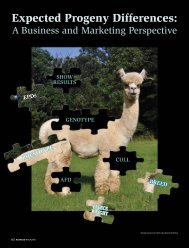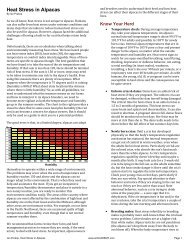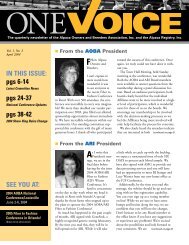IN THIS ISSUE: pg 4 pgs 9, 11 pgs 11-20 SEE YOU AT: - ariLIST
IN THIS ISSUE: pg 4 pgs 9, 11 pgs 11-20 SEE YOU AT: - ariLIST
IN THIS ISSUE: pg 4 pgs 9, 11 pgs 11-20 SEE YOU AT: - ariLIST
You also want an ePaper? Increase the reach of your titles
YUMPU automatically turns print PDFs into web optimized ePapers that Google loves.
Clarification of Current ARI Policy<br />
Regarding Microchipping<br />
The purpose of this article is to<br />
review current ARI policy regarding<br />
microchipping.<br />
In recent editions of OneVoice, the<br />
development of a National Animal<br />
Identification System (NAIS) by<br />
USDA/APHIS has been described, the<br />
objective of which is to be able to trace<br />
back domestic and foreign disease outbreaks<br />
within a 48 hour time frame, in<br />
order to control and manage animal<br />
disease. In conjunction with this, the<br />
Camelid Working Group (CWG) has<br />
been tasked with formulating recommendations<br />
for individual animal identification<br />
and data collection, specific<br />
to the camelid population in the<br />
United States.<br />
The AOBA/ARI Government and<br />
Industry Relations Committee<br />
(GIRComm) Report in the September<br />
<strong>20</strong>04 edition of OneVoice indicated<br />
that, effective July 1st of <strong>20</strong>05, microchipping<br />
would be required in order<br />
to complete the ARI registration<br />
process and, furthermore, that AOBA<br />
would be requiring that all alpacas<br />
entered at AOBA certified events be<br />
microchipped.<br />
On November 22nd, <strong>20</strong>04, the ARI<br />
Board approved a Policy regarding<br />
Alpaca Permanent Identification (Policy<br />
ID# ARI 04-06) in which it was recommended,<br />
but not mandated that<br />
microchips be utilized as permanent<br />
identification devices, in addition to the<br />
requirement that scientific blood testing<br />
(currently, DNA testing; prior to<br />
<strong>11</strong>/98, blood typing) be used for parentage<br />
verification and alpaca identification<br />
purposes, in the registration process.<br />
This Policy also permits the use of other<br />
methods of permanent identification,<br />
including “eartags, tattoos, and other<br />
permanent identification numbers.”<br />
8<br />
The CWG issued a Status Report<br />
on September 2nd, <strong>20</strong>04, in which<br />
devices and methods for camelid identification<br />
were described. The report<br />
mentioned that, at that time, records<br />
indicated that approximately 44%<br />
of ARI-registered alpacas (and 10%<br />
of ILR-registered animals) had a<br />
microchip implanted; indeed, it was<br />
felt that the percentage might be higher,<br />
but that the records might not yet<br />
have been updated to accurately reflect<br />
the actual percentage of microchipped<br />
camelids. The CWG indicated that<br />
camelid owners preferred microchip<br />
A microchip is about the size<br />
of a grain of rice.<br />
devices over other means of identification,<br />
i.e. eartags, while acknowledging<br />
that further study would be needed<br />
in order to establish the longevity, as<br />
well as the preferred location, of such<br />
devices. (In the December <strong>20</strong>04 edition<br />
of OneVoice, the Alpaca Research<br />
Foundation called for proposals to<br />
address this issue.) The CWG further<br />
acknowledged that other devices and<br />
methods might better suit the needs<br />
of industry for visibility and cost<br />
effectiveness. Hence, the Report concluded<br />
that the CWG would “need<br />
to continue to evaluate microchips<br />
and other identification devices”<br />
before making its recommendations<br />
to the USDA regarding a camelid<br />
identification plan.<br />
It has been GIRComm’s position<br />
that if the alpaca industry takes a<br />
proactive role in complying with<br />
microchipping (which it feels is the<br />
method of choice for alpaca identification),<br />
the USDA would accept this as<br />
THE method for camelid identification<br />
under the NAIS plan. However,<br />
in light of the CWG’s reluctance to<br />
recommend a specific form of identification<br />
for camelids at this point in<br />
time, it is ARI’s current position that<br />
it would be premature to require<br />
microchipping. Instead, ARI will continue<br />
to strongly support the use of<br />
microchipping for animal identification<br />
and encourage its members to<br />
notify the Registry of microchip<br />
numbers, for inclusion in its database<br />
and on certificates. ARI database and<br />
certificates have the capability of<br />
including (multiple) microchip numbers,<br />
as well as other forms of identification<br />
such as ear tag and tattoo numbers.<br />
Members will soon be able to<br />
enter this information online, in a<br />
secure fashion.<br />
The ARI Board is committed to<br />
serving the needs of all of its members,<br />
while at the same time welcoming<br />
the opportunity to work closely<br />
together with AOBA to serve its<br />
members, as well.<br />
We will continue to carefully consider<br />
the recommendations of the CWG<br />
and GIRComm, as we monitor the<br />
progress of the NAIS plan. If necessary,<br />
revisions will be made to ARI’s current<br />
policy, in order to affect and/or comply<br />
with USDA/APHIS guidelines.<br />
PO<strong>IN</strong>T OF CONTACT<br />
Dave Friedman, ARI Board Director<br />
alpacas@adelphia.net<br />
315-831-3040





